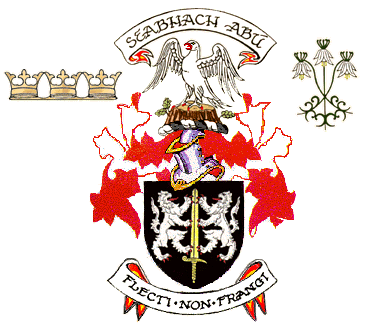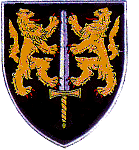| Irish Chiefs Back to Homepage |
Reports on the
Chiefships of O Doherty,
O Carroll, O Rourke and Mac Donnell
O Doherty of Inishowen | O Carroll of Ely O Carroll | O Rourke of Breifne | Mac Donnell of the Glens
Background
To date we have established that at least three Chiefs recognised in the period 1989-95 by the Office of the Chief Herald of Ireland/former Genealogical Office are bogus, namely, Mac Carthy Mór, Maguire of Fermanagh and O Long of Garranelongy. While recognition was withdrawn from Terence MacCarthy in 1999, no decisive action has been taken in relation to Maguire or O Long, other than a somewhat amorphous and on-off 'review of procedures' conducted by the Chief Herald. While sources within and close to the Office of the Chief Herald consistently denied that our June 1999 MacCarthy report played any part in the derecognition of MacCarthy, they were unable to explain why for so many years no action was taken on information that the his pedigree was bogus, with the result that more people were needlessly sucked into a million-dollar hoax. Neither can they explain why internal reviews of the cases of Maguire and O Long were only begun in the wake of our reports issued in 1999 and 2000. Of course the Office of the Chief Herald eventually simply washed its hands of responsibility by terminating the procedure of courtesy recognition of chiefs in July 2003, abandoning genuine and bogus chiefs alike.
Given that at least three of the Chiefs recognised by the Office of the Chief Herald between 1989-95 are bogus, it seems reasonable to wish to subject to close scrutiny the other four Chiefs recognised during this period. While cracking the cases of MacCarthy, Maguire and O Long required hundreds of hours work, perforce unpaid because of punitive exclusion from contract work, we were able to complete these particular investigations because all three Chiefs had been born in Ireland and records demonstrating their true pedigrees were accessible in Irish repositories. Unfortunately, three of the four remaining Chiefs were born abroad, namely, O Doherty, O Carroll and O Rourke, and we do not therefore have ready access to the records required to validate their pedigrees. The fourth Chief, Mac Donnell of the Glens, resides in Ireland, but it will be shown that while his pedigree can be verified, his claim is nonetheless problematic. The Office of the Chief Herald has refused access to file records relating to these four Chiefs on various grounds, the last being that ongoing reviews might be prejudiced by the release of information. Unfortunately, it has to be said that the tendency to obstruct or delay access to information is of long standing in the Office of the Chief Herald/former Genealogical Office, where there appears to be in play a rather confused and indeed very variable notion of the duty of discretion. Appeals against the refusal of access to records have been with the Freedom of Information Commissioner for a number of years. Although as a result of these gaps in information it has not been possible to finalise all aspects of our investigations into the O Doherty, O Carroll, O Rourke and Mac Donnell Chiefships, there follows a summary of progress to date in each of the four cases.
Given the historical prominence of the name, it is surprising that the Chiefship of O Doherty, Gaelic form Ó Dochartaigh, was not among those examined by Terence Grey (GO MS 610). The last Chief of the Name was Cahir O Doherty, who was killed in 1608 in the course of rebellion against the English. In or about 1990 the then Chief Herald Donal Begley issued a patent granting courtesy recognition as Chief of the Name to Ramon O'Dogherty of Spain. In an essay on the O Dohertys originally published before this recognition, Terence MacCarthy forecast that an O Doherty Chief could well be located in Spain (An Irish Miscellany, Little Rock, Arkansas, 1998, pages 188-89). Given MacCarthy's fraudulent representation of himself as Chief of the MacCarthys, it seemed doubly advisable to seek validation of the recognition of Ramon O'Dogherty in other sources.
While there was some communication difficulty caused by the writer's limited command of Spanish, Señor O'Dogherty helpfully supplied copy documentation supporting his right to the Chiefship, but in the form of secondary sources. The Office of the Chief Herald again refused to allow access to documents in the O Doherty file which might provide conclusive proof of the validity of the recognition. However, there is on display in the Heraldic Museum in Kildare Street a lengthy pedigree of O Doherty of Inishowen dated 1992, which is attributed to Deputy Chief Herald Fergus Gillespie. This pedigree traces the line of Chiefly descent after Cahir O Doherty through his brother John, down to three brothers, Henry, John and Clinton Dillon, who were sons of a John O Doherty who died 1784. These three brothers are said to have gone to Spain, where John became a naval officer and died in 1847, he being the great-great grandfather of the present recognised Chief Ramon. Our attention was drawn to some relatively recently published secondary sources which also reproduce this account of the family, including Brian Bonner's That Audacious Traitor (1985) and S F O'Dochartaigh's O'Doherty People and Places (1998).
Additionally, there is an Ulster's Office pedigree dated 1790 which takes the story as far as Henry, John and Clinton Dillon O Doherty (GO MS 165, pages 407-12). With the exception of a reference to the seventeenth-century elements having been extracted from the O Clery Book of Genealogies, the above mentioned 1992 pedigree is silent as to other primary sources used. In particular, there is no indication of the Spanish certificates proving the connection between John O Doherty died 1847 and the current Chief Ramon. While the present writer has been able to sustain the cost of nearly 1,000 hours work unpaid on his Chiefs research to date, it does not seem right, nor would it be practically possible for him to have to go to the additional expense of locating and securing copies of Spanish documents, particularly when they may already be in the files of the Office of the Chief Herald. Notwithstanding the fairly persuasive secondary evidence located, to be on the safe side the present writer cannot declare himself fully satisfied as to the validity of the recognition of Ramon O'Dogherty as Chief of the Name until such time as he is allowed to view adequate primary documentation.
There is also an anomaly in relation to the arms of O Doherty, in that there are two versions of same. The most ancient arms portray a springing stag and three mullets, whereas the arms certified by Ulster's Office in 1790 feature a chevron engrailed and three trefoils. Now in the matter of the dual arms of Andrew Davison, the bogus Count of Clandermond and associate of Terence MacCarthy, the current Chief Herald has recently ruled that a later grant automatically cancels an earlier one, and indeed he summarily nullifed both Davison arms. However, the 1992 O Doherty pedigree in the Heraldic Museum portrays both forms of the O Doherty arms, which hardly seems consistent with the decision in the Davison case.
 |
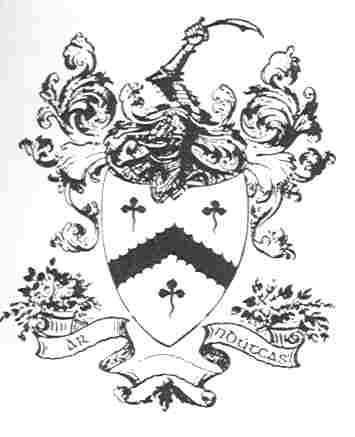 |
Traditional O Doherty Arms (left), and Arms used by O'Dogherty of Spain (right)
Thus while it is true that the O Doherty Chiefship seems the least questionable of those recognised in the period 1989-95, nevertheless there are certain issues requiring attention. In particular, what Spanish documents were presented in support of the application for recognition, and if they are in order why cannot they be opened to public inspection? The matter of the dual O Doherty arms is not insignificant, particularly as the ruling of the Chief Herald in the Davison case demonstrates inconsistency of practice. In summary, if the currently recognised O Doherty is genuine, he deserves to be freed of the pall of suspicion which other proven cases of fraud have cast over all Chiefs recognised during the years 1989-95.
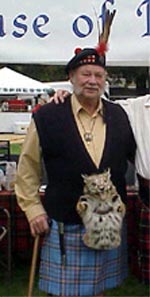
Having reviewed relevant manuscripts and published accounts in the 1940s, Terence Grey observed that the senior O Carroll line was probably extinct. He concluded therefore that the succession to the Chiefship must lie firstly with the Athgoe, County Dublin, branch, and if that failed, with the Litterluna, County Offaly, branch (GO MS 610, pages 53-54). However, no senior male representative of the family was apparently traced at that time by Grey and MacLysaght. We understand that it is claimed that the Athgoe branch is now extinct, but sight of relevant documentary evidence is required before this can be accepted.
As to the Litterluna line, it is claimed that the senior male representative is Frederick James O'Carroll of Stockton, California, and in 1993 Chief Herald Begley issued a certificate granting him courtesy recognition as Chief of the Name (GO MS 627). It seemed reasonable to ask for sight of the relevant documentary proof, particularly in view of the irregularities discovered in relation to other recognised Chiefs. While he did release copies of correspondence dated February 2000 concerning a query from the Court of the Lord Lyon in Edinburgh, where O'Carroll was seeking to have his arms matriculated, Chief Herald O Donoghue refused access to file documents relating to proof of pedigree. O'Carroll himself promised the writer some years back that he would provide copy documents to verify his pedigree, but these were never received. The Chief Herald also stated that while the arms of the currently recognised O Carroll were registered in 1983, no pedigree was ever registered, which is a cause for concern.
O'Carroll maintains a website at http://www.clancian-carroll.com/, which presents his 'Clan Cian' as a strange Irish-Scottish hybrid, complete with its own tartan and participation in American Highland gatherings. O'Carroll has also taken it upon himself to designate chieftains of branches of his 'clan', namely, 'MacStail' aka Stallone, Meagher, Bryant and Durnin (http://www.clancian-carroll.com/chieftainarmory.shtml). More than that, O'Carroll has declared a species of overlordship over hundreds of other Irish septs he apparently terms 'Cianachta', for example, Brogan of Mayo, MacBrady of Leitrim-Cavan, MacCleary of Antrim, O'Connor of Derry, and so on (from a long list on website as of 5 September 2008). This not unnaturally has not gone down well with other clan organisations, and an online critique of Mr O'Carroll's pretensions has now been published at http://www.geocities.com/elyocarroll_research/102.htm.
Mr O'Carroll's claimed descent, accepted by the Office of the Chief Herald and reproduced on its 1993 certificate of chiefly recognition, is as follows: James of Litterluna, alive 1763 - James b Ireland 1815, resided NY - James b Dublin 1840, d Galveston, Texas, 1921 - Michael Frederick b 'at sea' 1864, d California 1938 - Winfrey Frederick 1909-1969 - Frederick James, born 1933. Mr O'Carroll's birth certificate shows that his correct year of birth is 1936, but for some reason he has persistently stated that he was born in 1933, and clearly so informed the Chief Herald of Ireland. The present writer has been given to understand by other parties that Mr O'Carroll's true descent is from a Stephen Frederick aka Michael Frederick Carroll, born in Florida in 1867, parents James Caswell Carroll and Julia A C Watson, who died in 1922 and 1882 respectively and are buried in Crawford Cemetery, Texas (http://www.findagrave.com/cgi-bin/fg.cgi?page=gr&GSln=carroll&GScid=3103&GRid=20655140&). Stephen/Michael, also known as Frederick or Freddie, had two sons James Stephen and Orand Arboth with his first wife Julia Ann Salmon, had Winfrey Frederick and other children with a second wife Lily Hilda Masters, and having married thirdly Bertha Hanford in 1930, he died in Lassen County, California, in 1938. It has been suggested that there was some kind of rift between Stephen/Michael and his father, but after he made a new life in California contact was maintained with his family and the connection is remembered by the Texan branch even today.
Over the past few years, and with considerable difficulty and no little expense, I have sought to establish the truth of the matter, receiving copies of certain documents and acquiring others via official sources and Ancestry.com. Michael F Carroll's 1938 death certificate gives his place of birth as New York, and his parents are listed as unknown. Michael F Carroll's 1930 marriage certificate again states that he was born in New York, but names his parents as Jim Carroll and Julia Watson, both listed as born in Ireland. It has been suggested to the writer that Michael F Carroll's place of birth refers to New York, Texas, where James Caswell Carroll's family lived for a time, and not to New York, New York, and that furthermore the certificate information in relation to his parents' place of birth is erroneous. Michael F 'Mike' Carroll's will dated 1937 specifies that he was leaving nothing to his sons Stephen and Arron, which it is suggested are the above mentioned James Stephen and Orand Arboth. Now the genealogist must constantly be alive to coincidences of names, but it seems that these documents raise serious questions over Mr O'Carroll's claimed descent from an Irish chiefly line, which questions he has chosen not to answer, relying instead on certification provided by an Irish state heraldic office whose incompetence and low ethical standards have been clearly demonstrated in the Mac Carthy Mór and other cases of spurious claims to chiefship.
On 12 May 2000 'Chief' O'Carroll issued an appeal for donations towards an 'heraldic court fund', totalling about $5,000 and involving the erection of a banner in the Heraldic Museum in Dublin and a petition for matriculation of arms to the Lyon Court in Edinburgh. O'Carroll's website also draws attention to a seeming anomaly with regard to his arms, in that there appear to be two different forms, as shown below.
|
|
Variant forms of O Carroll Arms
The first arms, which feature two silver lions on a black background, were granted by the Chief Herald in 1983. The second arms, featuring two gold lions on a black background, appear on the 1993 patent of recognition (GO MS 627). It is claimed that the latter arms are those of William O Carroll, King of Éile, which the then Chief Herald allegedly assigned to O'Carroll in an 'amendment' of 1993, 'for Displayment with Authoritative and Protective Use and for Future Succeeding Chiefs of Name' (sic). Now as already noted, the current Chief Herald dealt with a similar anomaly in relation to dual arms of Andrew Davison, so-called Count of Clandermond, by cancelling both, so it will be interesting to see how he reacts in the case of the dual form of the O Carroll arms. Certainly, the discrepancy in relation to O'Carroll's arms was deemed sufficiently important to be raised by Lyon Court in its already mentioned correspondence with the Office of the Chief Herald.
In summary, we have uncovered evidence which raises serious questions about the validity of Mr O'Carroll's pedigree, arms and claim to chiefship. Again, what certificates and other primary sources were presented in support of O'Carroll's claim for recognition, and if they are in order, why cannot they be opened to public inspection? Is it not the case that rather than being descended from the chiefly Litterluna line, Mr O'Carroll is in fact a descendant of James Caswell Carroll of Florida, whose branch has no known chiefly connections? Taken with the already mentioned anomalies in relation to the Davison and O'Doherty arms, the dual form of the O'Carroll arms gives rise to further concern about the adequacy of heraldic practices in the Office of the Chief Herald. It has now been acknowledged, by no less a person than the Chairperson of the Board of the National Library, that a 'shambles' existed in the Office of the Chief Herald, and even though the office has detached itself from the process of recognising chiefs, unamended certificates in its records relating to bogus and questionable chiefs should be formally nullified.
In his deliberations on the O Ruairc or O Rourke pedigree, Terence Grey came to the conclusion in the 1940s that in default of other lines, the Chiefship might lie with Count O'Rourke of Russia (GO MS 610, pages 109-113). However, there is no evidence that contact was made with this individual and no decision was made by MacLysaght in relation to the succession to the O Rourke title. Grey did mention in passing a Surgeon-Commander Patrick Joseph Alfred O'Rourke of Strokestown, County Roscommon, who affected the title of Chief, and he referred also to the branch of the O Rourkes resident at Moylough, County Galway, but without indicating that it had a claim to the Chiefship.
There the matter lay until the revival of grants of courtesy recognition a half century later, and in 1993 Deputy Chief Herald Gillespie, and not then Chief Herald Begley, issued a patent granting courtesy recognition as Chief of the Name to a representative of the Moylough Branch, Geoffrey Philip Columb O'Rorke (GO MS 627, folio 56). Again there does not appear to be any registered pedigree in relation to this gentleman, and the Chief Herald has once more refused access to the information in the file on the case or to respond in detail to points raised.
Certain discrepancies have in fact been discovered by reference to accessible documents. In the first place, the 1993 patent of recognition gives the name of the son of Tadhg (Reverend Thaddeus) O'Rourke (died 1799), as Thomas (born 1782), whereas Grey gave his name as Timothy. We contacted O'Rorke about the matter and he provided the following explanation:
I can confirm that Timothy (or Thady) and Thomas are one and the same person. His father, the Rev Thaddeus O'Rorke (also known as Teige) converted to the Church of Ireland and thereafter was always known as Thomas. He was the Curate of Cong, Co Mayo, and indeed, his headstone bears the name Thomas. The Rev Timothy always referred to his father as Thomas and himself as well.
O'Rorke also referred the writer to a named professional genealogist for confirmation of all this, but a letter of enquiry to that source has gone unanswered. Now it may well be that all is as claimed, and that O'Rorke's ancestor did use the names Timothy and Thomas interchangeably, but of course precise documentary evidence would need to be presented, and this we have not seen.
In the second place, it has now emerged that this element of the O'Rourkes or O'Rorkes of Moylough is not in fact the senior branch of the family. (The Counts O'Rourke of Russia can also be ruled out of the reckoning, being an even more junior line.) There is actually a significant quantity of material relating to the O'Rourkes both in published and manuscript form. A good deal of this material was drawn to the present writer's attention by contributors to the Internet discussion group rec.heraldry, and in particular thanks are due to Sean MacLochlainn for providing a copy of a pedigree prepared by Lady Betty MacDermott (of course all conclusions arrived at here are those of the writer only). The last duly inaugurated Chief, Tadhg son of Brian na Múrtha, died in 1605, and it would appear that this line subsequently died out. A tract dated 1714 in the Royal Irish Academy shows that the O Rourke Chiefship was subject to a comparatively late determination under Brehon Law in 1662, when Eóghan Óg son of Eóghan Mór was judged to be Chief by the ollamháin of the Province of Connacht ('A Tract on the O'Rourkes', Celtica, 1, 1950, page 266). Interestingly, the anonymous author of this tract observed that seeking to establish to whom the title of Ó Ruairc was due might be 'to fight over an empty dish' (troid um asair fhailuibh), but it was nonetheless an important matter to him, as it should be to us.
The recognised Chief Geoffrey O'Rorke may indeed be descended from Eoghan Óg, but he would appear nonetheless not to be the senior representative of the family. Lady MacDermott's pedigree shows that Eoghan Óg's great-grandson, Tadhg, a Roman Catholic priest who converted to Protestantism and married, had two sons, both of whom became Church of Ireland ministers, the older being Reverend John and the younger being Reverend Timothy. It is from the latter individual, also possibly called Thomas as we have seen, that the currently recognised O Rourke Chief descends. However, the older son Reverend John had a large number of children, and Lady MacDermott's pedigree shows several lines of male descent down to the 1950s and 1960s. In particular, it would appear that the senior line descends via Sir George Maurice O'Rorke, a Speaker of the New Zealand House of Representatives. The position is summarised in the pedigree which follows, and efforts are in train to contact the indicated more senior line
Pedigree of O Rourke (O'Rorke), Moylough Branch
Brian Ballach Mór
d 1562
|
Tighearnán Bán
d post-1629
|
Eóghan Mór
d pre-1661
|
Eóghan Óg
Judged to be Chief 1662
|
Donnchadh
|
Seán
|
Tadhg/Rev Thaddeus
Former RC priest, d 1799
m his cousin Elinor O Rourke
|
__________________
| | Rev John 1776-1849 Moylough, Co Galway m 3 times, and had, with other sons | Sir George M 1830-1916 Speaker NZ H of R | Edward D 1864-1919 | Edward B 1901-1974 | (son) | (son) |
| Rev Timothy/ Thomas? Loughcrew, Co Meath b 1782 | Charles 1851-1925 Co Meath | Charles H 1881-1955 | Charles 1916-1985 | Geoffrey P C 1943- Current claimant to chiefship |
Sources:
Betty MacDermott, Pedigree of O Ruairc of Breifne, IGRS
Library, London, Boxfile 674, and
O Ruairc of Breifne, Manorhamilton, County Leitrim,
1990; James Carney Editor, 'A Tract on the O'Rourkes',
Celtica, 1, 1950, pages 258-279; Seamus Pender
Editor, 'The O Clery Book of Genealogies', Analecta
Hibernica,
18, 1951, pages 103-106; Register of Chiefs, GO MS 627, page
56.
Mac:Lysaght's criterion for recognition of Chiefs is clear: 'descent by primogeniture from the last formally inaugurated Chief' (More Irish Families, page 19). Subsequent to the publication of the first version of the present report, a letter dated 13 June 2001 was received from the Deputy Chief Herald, indicating that in effect there would be no reinvestigation of the O Rourke case until a more senior representative of the family actually entered a counter-claim, and that in any case the recognition granted was only provisional. This is a remarkably passive not to say lackadaisical approach contrasting with MacLysaght's and Grey's thorough checking of pedigrees, and indeed a sure recipe for continued disputes. As it would appear that the Office of the Chief Herald has once again set aside or ignored MacLysaght's criterion for granting courtesy recognition, the Register of Chiefs should be amended without delay by removal of the name of the currently recognised O Rourke Chief, pending a proper determination of who the senior representative of the family may be. The writer might be excused for protesting once again at being put to the trouble of devoting hours of unpaid work to unravelling this kind of official incompetence, and having to bear the additional insult of being derided by the Office of the Chief Herald as 'the self-appointed saviour of Irish genealogy'!
The current claimant to the title of Mac Donnell of the Glens is Count Randal MacDonnell, to whom a certificate granting courtesy recognition was issued in 1995 by Chief Herald Begley. This was the last such document issued by Begley before his retirement, and the MacDonnell arms featured include supporters, a distinction not granted to other chiefs by this Chief Herald. In fact there is no argument that this chief is not of the senior branch of the MacDonnells of Antrim, as his great-grandfather Randal William, born 1833, had an older brother Alexander, born 1829, who has living male descendants (Burke's Irish Family Records, page 758, column a). The present chiefly claimant has explained to the writer that those with a more senior claim to the title have waived same in documents deposited with the Office of the Chief Herald. Once again the said Office will not permit me to see these and other relevant documents relating to the case, and copy documents which MacDonnell promised to furnish have yet to be received. I was referred to a 1969 newspaper article which allegedly showed that MacDonnell's father, Robert, was recognised as a chief by the Office of the Chief Herald, but the piece in question is merely a diary entry reporting a claimed succession to the chiefship ('An Irishman's Diary', Irish Times, 30 September 1969). There is also some uncertainty over the family's claim to the title of 'Count of the Holy Roman Empire', as the title was originally bestowed on James MacDonnell of the Mayo branch in the eighteenth century, and it is not clear how it could have been simply transferred from one branch of the MacDonnells to another (John C O'Callaghan, History of the Irish Brigades, Glasgow 1870, page 201). Randal MacDonnell's claims to the titles of 'Count' and 'Mac Donnell of the Glens' have now also been criticised by a distant relative, the artist and author Hector MacDonnell (Walter J P Curley, Vanishing Kingdoms, Dublin 2004, page 68).
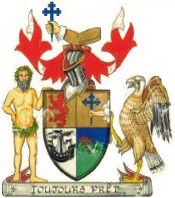
MacDonnell arms, with supporters
Randal MacDonnell played a sterling role in the campaign to unmask the imposter Terence MacCarthy, and on the other hand has been prominent in assisting the claimant to the title of Mac Sweeney Doe (see our report). Terence MacCarthy was instrumental in denying MacDonnell membership of the Standing Council of Irish Chiefs and Chieftains, apparently on the grounds that his is arguably a Scottish title and that the bearer is not the senior representative of the family. MacDonnell of course contests the first objection and believes that he can satisfactorily counter the second as well. Unfortunately, there is no escaping the fact that MacLysaght's rules require that recognition should be given to the senior descendant of the last duly inaugurated chief. Allowing for waiving of senior claims and substitution of family pacts comes perilously close to the 'Tanistry' advocated by Terence MacCarthy, although of course in contrast to MacDonnell, MacCarthy was not even of the great Munster sept whose chiefship he fraudulently claimed. Additionally, there does not appear to be any reference to an active Mac Donnell chiefship on the part of Gray or MacLysaght, and it seems that what we have here is a revival of a long disused or at least not publicly declared title.
A case could be made for revising MacLysaght's rules to allow for a junior line taking the chiefship where more senior lines were uninterested. However, it can be imagined how this might cause problems in the future, when a son or grandson might challenge the waiving by another of his rights to chiefship, thus replicating the instability and conflict which classical Tanistry undoubtedly tended to produce. Taking all these issues into account, and emphasising the want of seniority, once again we have to question the 1995 decision to enter the title Mac Donnell of the Glens in the Register of Chiefs.
Conclusion
The above reports have established that there are unanswered questions in relation to the granting of courtesy recognition by the Office of the Chief Herald in the case of each of the Chiefs O Dohery, O Carroll, O Rourke and Mac Donnell. What is the primary documentary evidence confirming the current claimant to the O Doherty title as Chief, and which are his correct arms? Are there not grounds to believe that the pedigree advanced by the claimant to the O Carroll title is in essence spurious, and furthermore why were two forms of his arms sanctioned? Why was the current claimant to the O Rourke title recognised as Chief when there appear to be other more senior lines of the family extant? Why was the current claimant to the Mac Donnell title recognised as Chief in spite of the fact that he also is not the senior representative of his family? These questions might be answered if the Office of the Chief Herald was to make available for inspection all the relevant documentary proofs in its files, but this it has refused to do. Notwithstanding the Office's abandonment of formal involvement with chiefs in 2003, the writer still believes that there is a case for a full and impartial official enquiry into the administration of the Office of the Chief Herald/former Genealogical Office, with particular reference to its granting of courtesy recognition to Chiefs of the Name in the period 1989-95.
Sean Murphy
Centre for Irish Genealogical and Historical Studies
25 April 2001, last updated 9 September 2008
